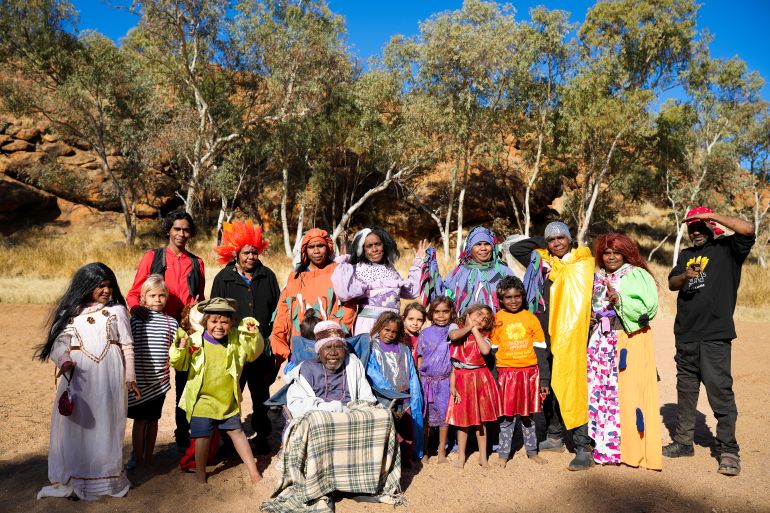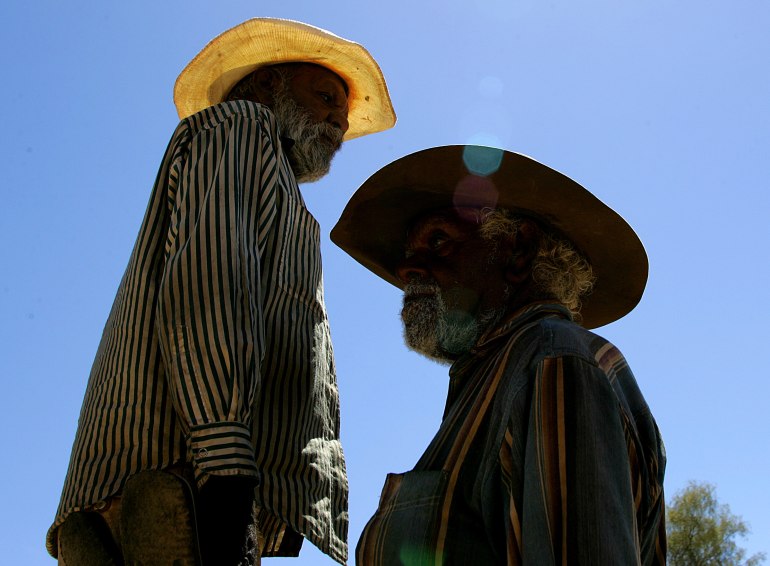Australian Aboriginal children sing their way back to language
Experts say it’s crucial for Arrernte children to start learning their Indigenous language at an early age for them to know and understand their culture and hope a new album will help.

Marking the United Nations International Decade of Indigenous Languages, an Aboriginal community in remote Central Australia is working on a ground-breaking new children’s album.
Ampe-mape Alyelheme (Kids Sing) is a collection of songs performed and recorded in the endangered Arrernte language.
Keep reading
list of 4 itemsAustralia sets stage for landmark Indigenous rights referendum
Prominent Indigenous Australian journalist quits over racism
Indigenous Australians file rights complaint over gas projects
Carol Turner, an Arrernte educator-turned-musician with Children’s Ground, the organisation leading the project, says that Ampe-mape Alyelheme “teaches and celebrates Arrernte language and culture through music”.
“We started this to keep our language strong,” she told Al Jazeera. “We want our kids to grow up with music and educational resources that reflect their culture – that can help them to learn, respect, speak, read, write and sing in their first language.”
Despite an estimated 800 diverse Indigenous languages thriving on the Australian continent before British colonisation in 1788, the Australian Bureau of Statistics says that only about 150 are now in daily use.
The remainder are either dormant or extinct, or in the process of revival through painstaking research into archival records produced by early colonists, missionaries and anthropologists.
Arrernte is only spoken by about 2,000 people; as such, projects such as Ampe-mape Alyelheme are vital for the language to continue into the next generation.
Cherisse Buzzacott, head of health and wellbeing from Children’s Ground, says the project addresses the lack of suitable language programmes in the education system.
“What we’re finding is, in the schools, [Arrernte language is] not really being privileged as an alternative to learning in the English language,” she said.
“We preference people to be able to be on Country [Indigenous traditional lands] and learn and speak Arrernte.”
Buzzacott – an Arrernte midwife and mother of three – says that learning the language at an early age is vital for Arrernte children to maintain and strengthen their culture.
She adds that there are also many terms relating to cultural practices and the relationship with the land that simply do not translate into English.
“Often, there are words that we can’t translate into English because there is no English translation,” she said. “We have to teach the little ones [the] language to pass on our culture.”
Buzzacott believes that a strong cultural identity provides Aboriginal people with some protection against the ongoing impacts of colonisation, such as racism, social exclusion and incarceration.

Indigenous Australians are one of the most imprisoned people on earth while Indigenous children are removed into state care at far greater rates than their non-Indigenous counterparts. These inequalities are considered a direct result of the inter-generational trauma of colonial policies.
“We know that the work that we’re doing is keeping kids out of the system because we’re engaging children,” she said.
“Through the work that we’re doing, we provide the kids with an identity and purpose by teaching them in the ways that they want to learn, which is through music and songwriting.”
Stolen Generations
Along with the destruction of language and culture wrought by colonisation, Australian governments enacted policies to restrict the use of Indigenous languages well into the 20th century.
Known as the Stolen Generations, Indigenous children were removed from their families and placed into institutions and orphanages.
Here, they would be punished for speaking their language and denied access to their families and cultural practices as part of an official effort to assimilate Aboriginal children into white society.
While the remote desert location of Arrernte communities kept the language and culture largely preserved against the onslaught of colonisation, on the east coast of the continent, Aboriginal languages were decimated.
Geoff Anderson is the Parkes Wiradjuri Language Group coordinator and director of First Languages Australia in present-day New South Wales.
His mother was one of the many tens of thousands of Indigenous children taken from their families as part of the assimilation programme.
As a result, Anderson did not grow up speaking his traditional Wiradjuri language, and it was only as an adult that he began to learn.
He told Al Jazeera that, until that point, it felt like there was “something missing”.
He agrees with Buzzacott that language and culture can assist with positive health and wellbeing.
“Mental state is the main thing,” he said. “And that’s what happened to me. There was something missing. That’s when the drugs and the alcohol come in. Because it’s got to do with identity and those types of things.”
Today, he teaches school students – Indigenous and non-Indigenous – Wiradjuri language and has also assisted in developing a language app.
But Anderson says more needs to be done to support Indigenous language projects and support people to learn.
“We need more language centres. More money,” he told Al Jazeera. “[But we also] need to get rid of the stigma. We’ve got to try and get the elders to get back into school because most of them didn’t go to school – or when they did, they were treated absolutely horribly.”
Musician and composer James Henry – who comes from the eastern Yuwaalaraay and Gamilaraay peoples – is another Aboriginal man who did not grow up with his language.
However, he has recently delved into archival recordings and has begun reviving music, traditional stories and language through contemporary music styles, including techno, folk and classical.
He told Al Jazeera that, traditionally, Indigenous music was centred on the spoken language.
He says this reflects the importance of music in maintaining and passing on cultural knowledge.
“The music is such a great carrier of information and knowledge; information was prioritised. It’s kind of like the songs are the encyclopaedia of Aboriginal history, wisdom and understanding,” he said.
However, he told Al Jazeera that, as an adult, music was a great way to learn his original language, and he highlighted the important role music projects could have in learning and maintaining Aboriginal languages.
“There aren’t that many people that speak my language fluently,” he said. “Music is almost like training wheels for the language in that songs: In order to perform them – [it requires] repetition.”
Global risk to Indigenous languages
The threat that colonisation has created for Indigenous languages has been mirrored in countries beyond Australia.
The United Nations estimates that up to 95 percent of languages will become ‘extinct or seriously endangered’ by the end of this century, most of them Indigenous.
In Australia, experts say more needs to be done not only to see the languages survive but to thrive as well.
Jill Wigglesworth, a professor in the School of Languages and Linguistics at Melbourne University, says that despite the efforts of community groups like Children’s Ground and Anderson’s language group, the survival of Indigenous languages remains “very dire”.
“There are now only between 10 and 12 languages that are still being learned by children as a first language,” she said. “The vast majority of education that Indigenous children get is in English.”
She argues that bilingual schools would be an ideal way to traverse the cultural divide, as well as to recognise the pragmatic necessity to learn English.
“There used to be a number of bilingual programmes, but they’ve tended to become unfunded over the years,” she said. “You do need particular training to be able to work in bilingual programmes. And that tends not to be provided. And of course, they’re more expensive, which people aren’t really prepared to pay for.”
However, Wigglesworth says that finding the balance is “not an easy question”.
“But I think, certainly, there needs to be a lot more engagement with the local communities,” she said. “There needs to be a really hard look at how more Indigenous people can be trained as teachers and become teachers in their communities.”